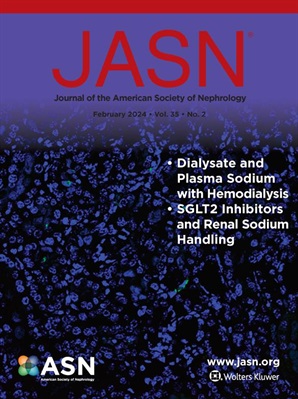潜能不确定的克隆性造血与慢性肾脏病的进展。
IF 10.3
1区 医学
Q1 UROLOGY & NEPHROLOGY
引用次数: 0
摘要
克隆性不确定潜能造血(CHIP)是一种常见的衰老炎症,可导致无数终末器官损伤。在一般人群中,CHIP与AKI事件和肾功能下降有关,尤其是DNMT3A以外的CHIP基因突变(称为非DNMT3A CHIP)。先前对CKD患者CHIP的研究样本量有限,结果相互矛盾。方法:我们研究了4个CKD队列(N = 5654)的CHIP和CKD进展情况:慢性肾功能不全队列(CRIC)、非裔美国人肾脏疾病研究(AASK)、来自BioVU生物库的CKD患者,以及加拿大死亡、透析和中期心血管事件预测研究(canpredict)。主要结局是CKD进展(eGFR下降50%或肾衰竭)和eGFR随时间的斜率。此外,在饮食腺嘌呤诱导的CKD小鼠Tet2-CHIP模型中评估肾脏功能和病理。结果所有队列的平均年龄为66±11岁,平均基线eGFR为43±15 ml/min/1.73m2, 24%患有CHIP。经过荟萃分析,非dnmt3a CHIP与发生CKD进展的相对风险增加64%相关(风险比[HR] 1.64;95%可信区间[CI], 1.00-2.68),在基线eGFR为30-60 ml/min/1.73m2的个体中观察到的效果最强(HR 1.85, 95% CI: 1.18-2.90)。非dnmt3a CHIP携带者的eGFR下降速度也更快(β, -0.62±0.28 ml/min/1.73m2 /年;P = 0.03)。在饮食腺嘌呤CKD小鼠模型中,Tet2-CHIP与较低的GFR以及更大的肾脏炎症、小管损伤和小管间质纤维化相关。结论:非dnmt3a CHIP与CKD患者的CKD进展相关。此外,Tet2-CHIP小鼠模型支持肾损伤的因果作用。本文章由计算机程序翻译,如有差异,请以英文原文为准。
Clonal Hematopoiesis of Indeterminate Potential and Progression of CKD.
BACKGROUND
Clonal hematopoiesis of indeterminate potential (CHIP) is a common inflammatory condition of aging that causes myriad end-organ damage. CHIP has been associated with incident AKI and kidney function decline in the general population, particularly mutations in CHIP genes other than DNMT3A (termed non-DNMT3A CHIP). Prior studies of CHIP in individuals with CKD had limited sample sizes and conflicting findings.
METHODS
We examined CHIP and CKD progression in four CKD cohorts (N = 5,654): the Chronic Renal Insufficiency Cohort (CRIC), the African American Study of Kidney Disease (AASK), individuals with CKD from the BioVU biorepository, and the Canadian study of prediction of death, dialysis and interim cardiovascular events (CanPREDDICT).Primary outcomes were incident CKD progression (50% eGFR decline or kidney failure), and eGFR slope over time. In addition, kidney function and pathology were assessed in a Tet2-CHIP mouse model of CKD induced by dietary adenine.
RESULTS
Across all cohorts the average age was 66 ± 11 years, with an average baseline eGFR of 43 ± 15 ml/min/1.73m2, and 24% had CHIP. After meta-analysis, non-DNMT3A CHIP was associated with a 64% higher relative risk of incident CKD progression (hazard ratio [HR] 1.64; 95% confidence interval [CI], 1.00-2.68), with the strongest effect observed in individuals with baseline eGFR 30-60 ml/min/1.73m2 (HR 1.85, 95% CI: 1.18-2.90). Non-DNMT3A CHIP carriers also exhibited a faster eGFR decline (β, -0.62 ± 0.28 ml/min/1.73m2 per year; P = 0.03). In a dietary adenine mouse model of CKD, Tet2-CHIP was associated with lower GFR as well as greater kidney inflammation, tubular injury, and tubulointerstitial fibrosis.
CONCLUSIONS
Non-DNMT3A CHIP was associated with CKD progression among individuals with CKD. Further, Tet2-CHIP mouse models support a causal role in kidney injury.
求助全文
通过发布文献求助,成功后即可免费获取论文全文。
去求助
来源期刊
CiteScore
22.40
自引率
2.90%
发文量
492
审稿时长
3-8 weeks
期刊介绍:
The Journal of the American Society of Nephrology (JASN) stands as the preeminent kidney journal globally, offering an exceptional synthesis of cutting-edge basic research, clinical epidemiology, meta-analysis, and relevant editorial content. Representing a comprehensive resource, JASN encompasses clinical research, editorials distilling key findings, perspectives, and timely reviews.
Editorials are skillfully crafted to elucidate the essential insights of the parent article, while JASN actively encourages the submission of Letters to the Editor discussing recently published articles. The reviews featured in JASN are consistently erudite and comprehensive, providing thorough coverage of respective fields. Since its inception in July 1990, JASN has been a monthly publication.
JASN publishes original research reports and editorial content across a spectrum of basic and clinical science relevant to the broad discipline of nephrology. Topics covered include renal cell biology, developmental biology of the kidney, genetics of kidney disease, cell and transport physiology, hemodynamics and vascular regulation, mechanisms of blood pressure regulation, renal immunology, kidney pathology, pathophysiology of kidney diseases, nephrolithiasis, clinical nephrology (including dialysis and transplantation), and hypertension. Furthermore, articles addressing healthcare policy and care delivery issues relevant to nephrology are warmly welcomed.

 求助内容:
求助内容: 应助结果提醒方式:
应助结果提醒方式:


